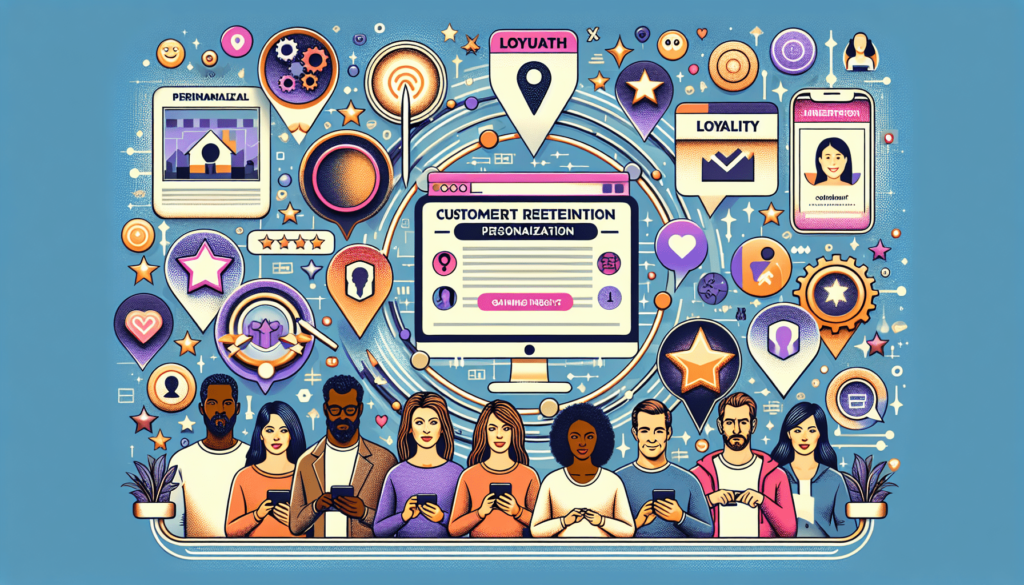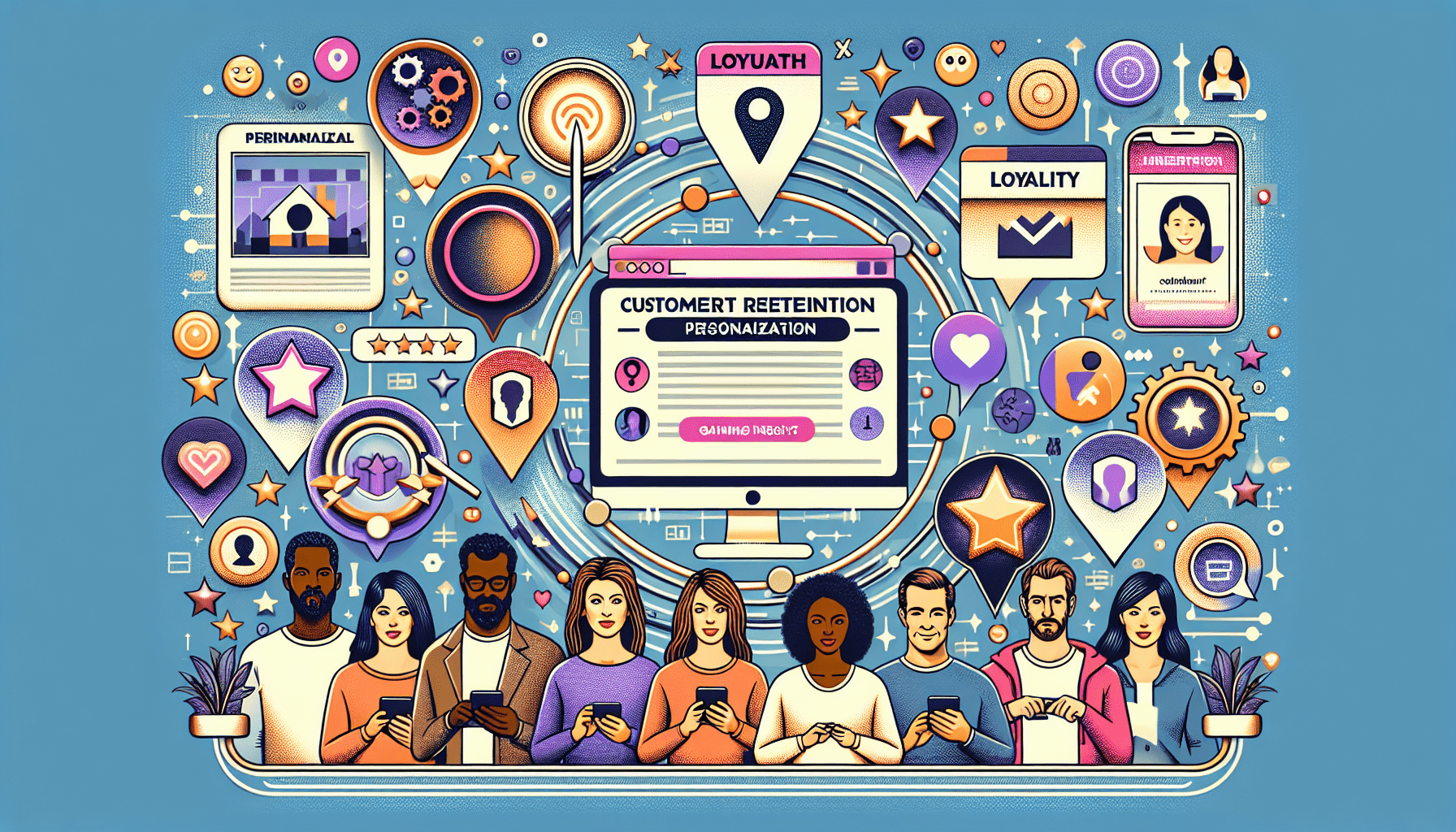In today’s digital age, building customer loyalty is more important than ever. As businesses continue to expand their online presence, the challenge lies in finding effective strategies to retain customers and keep them coming back for more. This article will explore various ways in which you can enhance customer retention online, from personalized communication to providing exceptional customer service. Discover the key techniques that can help your business build lasting relationships with customers and ultimately boost your online success.

Provide Excellent Customer Service
Offer 24/7 Live Chat Support
One of the best ways to provide excellent customer service is by offering 24/7 live chat support. This ensures that your customers can reach out to you at any time of the day or night and receive prompt assistance. By having a live chat feature on your website, you give customers the opportunity to have their questions answered and their concerns addressed in real-time, which can greatly improve their overall experience with your brand.
Respond Promptly to Customer Inquiries
Another crucial aspect of excellent customer service is responding promptly to customer inquiries. Whether it’s through email, social media, or phone calls, it’s important to establish a system that allows you to respond to customer inquiries in a timely manner. This shows your customers that you value their time and are committed to resolving their issues as quickly as possible.
Train Support Staff to Be Knowledgeable and Helpful
To provide excellent customer service, it’s essential to have a well-trained support staff. Your support team should not only be knowledgeable about your products or services but also be equipped with the skills to handle customer inquiries and resolve issues effectively. By investing in training and development programs for your support staff, you can ensure that they are well-prepared to provide helpful and accurate assistance to your customers.
Personalize Customer Interactions
Personalizing customer interactions is another effective way to provide excellent customer service. Every customer is unique and has different preferences and needs. By taking the time to understand your customers and their specific requirements, you can tailor your interactions to meet their expectations. Whether it’s addressing them by their name, remembering their past purchases, or providing personalized recommendations, these small gestures can make a significant impact on the overall customer experience.
Build Customer Trust
Be Transparent with Pricing and Policies
Building customer trust begins with being transparent about your pricing and policies. Clearly displaying your prices and being upfront about any additional fees or charges helps customers make informed decisions. Additionally, clearly outlining your return, refund, and cancellation policies can help customers feel more confident in making a purchase from your business.
Maintain Secure Payment Systems
Another crucial aspect of building customer trust is maintaining secure payment systems. Customers want to feel safe when making online purchases, and by implementing secure payment systems, you can assure them that their personal and financial information is protected. This can be achieved by partnering with trusted payment processors and regularly updating your systems to comply with industry standards.
Display Trust Seals and Certifications
Displaying trust seals and certifications on your website is another effective way to build customer trust. Trust seals indicate that your business has undergone security and compliance assessments, giving customers peace of mind when engaging with your brand. By prominently displaying these seals, you can show customers that you prioritize their safety and take the necessary steps to protect their data.
Collect and Display Customer Reviews and Testimonials
Collecting and displaying customer reviews and testimonials is an excellent way to build customer trust. Positive reviews and testimonials serve as social proof, indicating that other customers have had positive experiences with your products or services. By featuring these reviews on your website, you not only build trust with potential customers but also encourage existing customers to share their feedback, further strengthening your brand’s reputation.
Offer Competitive Pricing and Promotions
Regularly Monitor Competitor Prices
To offer competitive pricing, it’s important to regularly monitor competitor prices. By keeping an eye on your competitors’ pricing strategies, you can adjust your prices accordingly to remain competitive in the market. This not only helps attract new customers but also encourages existing customers to continue purchasing from your business instead of switching to a competitor offering a better price.
Offer Discounts and Special Offers
One effective way to attract and retain customers is by offering discounts and special offers. Whether it’s through promotional codes, limited-time offers, or loyalty programs, providing customers with opportunities to save money on their purchases can incentivize them to choose your brand over others. Additionally, offering exclusive discounts to repeat customers can help foster loyalty and encourage them to continue shopping with you.
Provide Loyalty Programs and Rewards
Implementing loyalty programs and rewards is another effective strategy to encourage repeat purchases and build customer loyalty. By offering rewards such as points, discounts, or exclusive access to special events or products, you can show your appreciation for your customers’ continued support. These programs not only incentivize customers to keep coming back but also make them feel valued and recognized for their loyalty.
Implement Price-Matching Policies
Implementing price-matching policies can help you retain customers who are price-sensitive and actively compare prices across different platforms. By matching or even beating the prices offered by your competitors, you demonstrate that you are committed to offering the best value to your customers. This can significantly improve customer satisfaction and loyalty.
Enhance User Experience and Website Design
Ensure Easy Navigation and Intuitive Layout
Enhancing user experience begins with ensuring easy navigation and an intuitive layout on your website. A user-friendly interface allows customers to quickly find the information they are looking for and navigate through your website without any confusion. Clear and organized menus, search functionality, and logical page hierarchies contribute to a seamless browsing experience, improving customer satisfaction and decreasing bounce rates.
Optimize Website Load Speed
Website load speed is another crucial factor in enhancing user experience. Slow loading times can frustrate customers and lead to high bounce rates. To optimize website load speed, minimize large file sizes, compress images, and remove unnecessary scripts. By ensuring that your website loads quickly, you can create a positive first impression and keep customers engaged.
Make Checkout Process Simple and Efficient
Simplicity and efficiency in the checkout process can greatly enhance the user experience. A streamlined and intuitive checkout process reduces friction and increases the likelihood of customers completing their purchases. Minimize the number of steps required to complete a transaction, offer guest checkout options, and provide clear instructions and progress indicators to guide customers through the process.
Provide Mobile-Friendly Design
With the rise in mobile usage, it’s essential to provide a mobile-friendly design for your website. Mobile responsiveness ensures that your website is optimized for various screen sizes and devices. By providing a seamless browsing experience across desktops, tablets, and smartphones, you can cater to the preferences of your customers and make it easy for them to engage with your brand on any device.

Create Engaging and Relevant Content
Publish Informative Blog Posts and Articles
Creating engaging and relevant content is key to attracting and retaining customers. Publishing informative blog posts and articles related to your industry or niche establishes your brand as a thought leader and provides value to your customers. Share insights, tips, and industry trends to demonstrate your expertise and keep customers engaged with your content.
Curate Useful Guides and Tutorials
Curating useful guides and tutorials is another effective way to provide value to your customers. By offering comprehensive guides or tutorials that help customers solve common problems or learn new skills, you position your brand as a helpful resource. This not only encourages customers to return to your website but also increases the likelihood of them recommending your brand to others.
Share Customer Success Stories
Sharing customer success stories can be a powerful tool in building trust and showcasing the value of your products or services. Highlighting real-life examples of how your offerings have positively impacted customers can inspire potential customers and reinforce the credibility of your brand. By featuring these success stories on your website or social media channels, you can create a sense of community and foster trust among your audience.
Leverage Email Newsletters and Personalization
Utilizing email newsletters and personalization is a great way to stay engaged with your customers. Regularly sending out newsletters with relevant content and personalized offers or recommendations shows that you value your customers’ interests and preferences. Segment your email list based on demographics, purchase history, and browsing behavior to ensure that the content you send is tailored to each customer’s needs.
Implement Targeted Marketing Strategies
Segment Customers Based on Purchase History and Preferences
Segmenting your customers based on their purchase history and preferences is an effective way to tailor your marketing strategies. By categorizing your customers into specific groups, you can create targeted campaigns that speak directly to their interests. This personalization can significantly increase engagement and conversions, as customers are more likely to respond to messages that are relevant to their specific needs.
Use Personalized Email Marketing Campaigns
Personalized email marketing campaigns are a powerful tool for engaging customers. By using customer data such as their name, purchase history, or browsing behavior, you can craft tailored email campaigns that resonate with each individual. Personalized emails create a sense of exclusivity and enhance the customer’s connection with your brand, leading to higher open rates and click-through rates.
Leverage Retargeting Ads
Retargeting ads are an effective way to reach out to customers who have previously visited your website but did not make a purchase. By displaying targeted ads to these customers as they browse the internet, you can remind them of your brand and encourage them to return to make a purchase. Retargeting ads are a powerful tool for increasing conversion rates and recapturing lost sales.
Utilize Social Media Advertising
Social media advertising is another valuable channel for targeted marketing. By utilizing the targeting capabilities of platforms such as Facebook, Instagram, and Twitter, you can reach your desired audience based on demographics, interests, and behaviors. Social media ads allow you to tailor your message and creative to specific customer segments, ensuring that your marketing efforts are seen by the right people.
Provide Seamless and Secure Payment Options
Accept a Variety of Payment Methods
To provide seamless payment options, it’s crucial to accept a variety of payment methods. Customers appreciate having choices when it comes to payment, whether it’s credit cards, debit cards, digital wallets, or alternative payment methods. By offering a wide range of payment options, you cater to the preferences of different customers and make it convenient for them to complete their purchases.
Partner with Trusted Payment Processors
Partnering with trusted payment processors is essential for maintaining secure payment systems. Choose payment processors that are known for their reliability, security features, and fraud prevention measures. By partnering with reputable payment processors, you ensure that your customers’ sensitive information is handled securely and that their payment transactions are protected.
Offer Guest Checkout Option
Offering a guest checkout option is another way to provide a seamless payment experience. Some customers prefer not to create an account or provide personal information during the checkout process. By giving them the option to checkout as a guest, you remove any barriers to completing their purchase, increasing the likelihood of conversion.
Ensure PCI Compliance
Maintaining Payment Card Industry Data Security Standard (PCI DSS) compliance is essential for ensuring the security of your payment systems. PCI compliance involves implementing security measures to protect cardholder data during the payment process. By adhering to PCI standards, you demonstrate to your customers that you take their payment security seriously and provide them with peace of mind.
Deliver Exceptional Post-Purchase Support
Send Order Confirmation and Shipment Updates
Delivering exceptional post-purchase support begins with sending order confirmation and shipment updates. Customers appreciate timely communication regarding the status of their orders. By sending order confirmation emails immediately after a purchase and providing regular updates on shipment progress, you keep customers informed and alleviate any anxiety they may have about their purchase.
Provide Easy Returns and Exchanges
Making returns and exchanges easy for customers is an important part of post-purchase support. Sometimes, customers may need to return or exchange a product due to various reasons. By providing clear return and exchange policies, offering hassle-free return processes, and providing pre-paid return shipping labels, you remove any obstacles for customers who may want to return or exchange their purchases.
Offer Product Support and Troubleshooting
Offering product support and troubleshooting assistance is another key way to deliver exceptional post-purchase support. Some customers may encounter issues or have questions about using your products. By providing easily accessible resources such as FAQs, knowledge bases, or dedicated support channels, you empower customers to troubleshoot and resolve their issues efficiently, leading to a positive post-purchase experience.
Follow up with Customer Satisfaction Surveys
Following up with customer satisfaction surveys is a valuable practice to gather feedback and continuously improve your post-purchase support. Sending out surveys after customers have received their orders allows you to gauge their satisfaction levels, identify areas for improvement, and address any concerns they may have. By actively soliciting feedback, you show customers that their opinions matter and that you are committed to providing the best possible post-purchase experience.
Foster Customer Engagement and Community
Encourage Customer Reviews and Ratings
Encouraging customer reviews and ratings is an effective way to foster customer engagement and build a sense of community. Actively invite customers to leave reviews and ratings on your website or third-party platforms. Positive reviews can attract new customers, while addressing and resolving negative reviews demonstrates your dedication to customer satisfaction.
Create Online Forums or Community Groups
Creating online forums or community groups provides a space for customers to connect with each other and engage with your brand. These platforms allow customers to ask questions, share experiences, and provide support to one another. By facilitating these interactions, you foster a sense of community among your customers and create a space where they can engage with your brand on a deeper level.
Organize Contests and Giveaways
Organizing contests and giveaways is a fun way to engage customers and reward their loyalty. Whether it’s through social media promotions, email campaigns, or website-based giveaways, these initiatives encourage customers to interact with your brand and spread the word to their friends and family. Contests and giveaways create excitement and a sense of exclusivity, further building the connection between your brand and its customers.
Respond to Social Media Comments and Messages
Engaging with customers through social media is another important aspect of fostering customer engagement. Responding to comments and messages on platforms like Facebook, Instagram, and Twitter shows that you value customer feedback and are actively listening. By providing timely and helpful responses, you demonstrate your commitment to customer satisfaction and build a positive brand image.
Monitor and Analyze Customer Behavior
Use Website Analytics Tools
Using website analytics tools allows you to monitor and analyze customer behavior on your website. These tools provide valuable insights into metrics such as website traffic, conversion rates, and customer demographics. By tracking these metrics, you can identify trends, understand customer preferences, and make data-driven decisions to optimize your website and marketing strategies.
Track Key Metrics like Churn Rate and Lifetime Value
Tracking key metrics such as churn rate and lifetime value helps you understand the health of your customer relationships. Churn rate represents the percentage of customers who stop purchasing from your business, while lifetime value measures the total revenue generated by a customer over their lifetime. By monitoring and analyzing these metrics, you can identify opportunities to improve customer retention and increase overall profitability.
Utilize Customer Feedback and Surveys
Utilizing customer feedback and surveys is an effective way to gain insights into customer satisfaction and preferences. Implementing feedback mechanisms such as customer surveys, feedback forms, or review requests helps you collect valuable data directly from your customers. This feedback can uncover areas of improvement, highlight customer pain points, and inform your decision-making process.
Monitor Social Media Mentions and Sentiment
Monitoring social media mentions and sentiment allows you to stay connected with customers and gain insights into their perceptions of your brand. Tools such as social listening platforms help you track mentions of your brand across social media channels and analyze sentiment (positive, neutral, or negative). By monitoring social media, you can respond to customer feedback and proactively address any issues or concerns.

